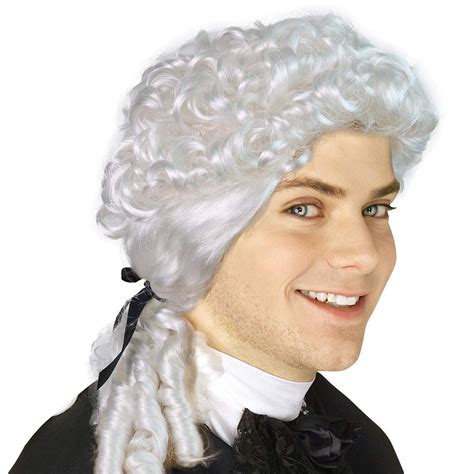The classical powdered wig has been a symbol of elegance and sophistication for centuries. Its intricate designs and delicate craftsmanship have adorned the heads of kings, queens, and celebrities alike. Today, powdered wigs continue to grace the stages of opera houses and theaters, adding an air of authenticity to historical productions.

History of Powdered Wigs
The powdered wig originated in the 17th century during the reign of Louis XIV of France. Initially, wigs were worn to conceal hair loss and imperfections caused by diseases like syphilis. However, over time, they evolved into elaborate fashion statements, becoming symbols of wealth and status.
By the 18th century, powdered wigs had become an integral part of court dress for both men and women. The most popular style of the time was the “full-bottomed wig,” which featured long, flowing curls that cascaded over the shoulders. Wigs were often embellished with ribbons, lace, and jewels, adding to their opulence.
The Process of Powdering a Wig
Creating a powdered wig was a time-consuming and labor-intensive process. The hair used to make the wig was typically from human sources, such as prisoners or the poor. The hair was cleaned, bleached, and then shaped into the desired style using hot irons.
Once the wig was styled, it was powdered with a mixture of wheat starch and perfume. This process helped to lighten the color of the hair and give it a soft, matte finish. The powder also acted as a hairspray, holding the wig in place.
Modern Uses of Powdered Wigs
While powdered wigs are no longer a common sight in everyday life, they continue to be used in certain contexts:
- Historical Reenactments: Powdered wigs are essential for recreating the authentic appearance of historical figures from the 17th and 18th centuries.
- Opera and Theater: Powdered wigs add an element of grandeur to stage productions, especially those set in historical periods.
- Costuming: Powdered wigs are popular props for Halloween costumes, particularly those inspired by historical or literary characters.
Creative Applications of Powdered Wigs
Beyond their traditional uses, powdered wigs can inspire creativity in various ways:
- Art Installations: Contemporary artists have used powdered wigs to create thought-provoking installations that explore themes of identity and history.
- Fashion Design: Powdered wigs have been incorporated into high-fashion collections, adding a touch of whimsy and theatricality.
- Hairdressing: Modern hairdressers use powdered wigs as a starting point for creating unique and elaborate hair sculptures.
Tables
Table 1: Estimated Cost of a Powdered Wig
| Type of Wig | Cost |
|---|---|
| Full-bottomed Wig (18th Century) | $1,000 – $5,000 |
| Half-bottomed Wig (17th Century) | $500 – $1,500 |
| Short Hair Wig (Renaissance Period) | $200 – $500 |
Table 2: Comparison of Popular Wig Styles
| Style | Period | Description |
|---|---|---|
| Full-bottomed Wig | 18th Century | Long, flowing curls that cascade over the shoulders |
| Half-bottomed Wig | 17th Century | Shorter, less voluminous curls that cover the back of the head |
| Short Hair Wig | Renaissance Period | Short, close-cropped hair that resembles a modern pixie cut |
Table 3: Techniques for Powdering a Wig
| Technique | Description |
|---|---|
| Dry Powdering | Sprinkling the powder onto the wig using a brush or hand |
| Wet Powdering | Mixing the powder with water to create a paste that is applied to the wig |
| * Table 4: Benefits of Wearing a Powdered Wig | |
| Benefit | Description |
| — | — |
| Enhances Appearance | Creates a more sophisticated and elegant look |
| Conceals Hair Imperfections | Covers up hair loss, thinning, or other hair problems |
| Provides Warmth | Protects the head from cold temperatures |
| Adds Height | Can make the wearer appear taller |
| Creates a Historical or Theatrical Atmosphere | Adds authenticity to historical reenactments or stage productions |
Effective Strategies for Maintaining a Powdered Wig
- Brush Regularly: Brush the wig gently to remove tangles and keep it looking its best.
- Powdering: Repowder the wig as needed to maintain the desired level of whiteness and color.
- Avoid Contact with Water: Water can damage the wig and remove the powder.
- Store Carefully: Store the wig in a cool, dry place when not in use.
Tips and Tricks for Using Powdered Wigs
- Choose a Style that Complements Your Features: Select a wig style that suits your face shape and personal style.
- Use the Right Type of Powder: Different types of powder can have different effects on the wig. Experiment with various powders to find the one that works best.
- Apply Powder Sparingly: Over-powdering can make the wig look artificial and heavy.
- Accessorize: Add ribbons, lace, or jewels to the wig to enhance its appearance.
- Consider a Custom-Fitted Wig: A well-fitted wig will be more comfortable to wear and look more natural.
